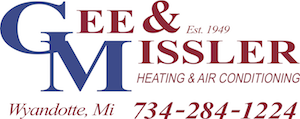
Choosing the proper furnace filter and changing it when it is dirty is as important to your HVAC system as changing the oil is to your car. Each plays a vital role in keeping its system working safely, efficiently and for a long time.
An overused furnace filter loses its effectiveness, permitting potentially harmful particles to move through your home. It also limits airflow, which can damage your furnace and decrease its life span.
Making sure your furnace uses a clean filter that is ideal for your needs is not merely about keeping your furnace operating efficiently. It’s also about creating healthy indoor air quality for your home.
The health of your family is important to the heating pros at Gee & Missler Heating & Air Conditioning. We've long been dedicated to enhancing indoor air quality in Wyandotte. Here, we’ve answered frequent questions about HVAC filters, including that very tricky question of what direction do you point a filter in your furnace or air conditioner?
When Should I Replace My Furnace Air Filter?
It's important to replace dirty air filters in a furnace or air conditioner regularly. Dirt-clogged filters cause the system to worker harder than it should because it takes more energy to move air through the plugged-up filter.
Officials recommend checking your furnace filter every 30 days and replacing it if it’s dirty. You’ll know if it is dirty because it will filled with dirt or dust. Those who have dogs and cats will likely have to replace their furnace air filter more often, because a good air filter will trap pet hair circulating in a home.
Where Is the Air Filter in My Furnace?
In general, a furnace air filter is usually installed in the return air duct or blower compartment before the return air goes back into the furnace. This is so air flowing into the system is filtered before it goes through the furnace components and is heated.
Depending on the furnace model, the filter may be positioned on the right, left, bottom or in some cases, on the inside of the furnace. It's generally housed within a slot, frame or cabinet for simple access and replacement. Always refer to your furnace's owner manual for information about filter location of your particular brand and model of furnace.
Are Air Filters and Furnace Filters the Same Thing?
The simple answer is, yes. In HVAC, a furnace filter and an air filter or air conditioning filter are effectively the same thing. While people might refer to them differently based on the current season— warm or chilly months—they are all filters that clean the air in your HVAC system.
They each remove dust, allergens, bacteria and other contaminants from the air that is drawn into the furnace and air conditioning system, making sure the air circulating throughout your home is clean and safe.
What Is a MERV Rating and What MERV Rating Do I Need?
Once you find your old furnace filter and determine when it should be substituted for a clean one, it’s time to select a replacement. That means picking the level of filtration that you need. One approach to this is by choosing an appropriate MERV rating for your needs.
MERV stands for Minimum Efficiency Reporting Values. The MERV rating measures the effectiveness of air filters at trapping airborne contaminants. The rating scale ranges from 1 to 20, with higher numbers indicating a greater ability to filter tinier particles.
Experts say a filter with a MERV rating between 8 and 13 offers an ideal balance between having healthy indoor air quality without unnecessarily restricting airflow. However, people with certain health conditions may need to use a filter with a higher MERV rating.
Which Way to Put the Air Filter in a Furnace or Air Conditioning System
Putting an air filter in a furnace or air conditioner correctly is crucial for the efficient operation of the heating or cooling system. Air filters are supposed to face a particular direction, indicated by an arrow located on the side of the filter frame. The filter should be put in with this arrow pointing in the direction of the furnace or air conditioning unit, which is the direction of the airflow. If you're doubtful about the airflow direction, try to remember that air always moves from the return duct towards the heat or cooling source. Therefore, make certain the arrow points in the direction of the furnace or air conditioner.
Many people struggle with which direction to point their air filter. To help remember, consider snapping a quick photo with your cellular phone after the filter has been accurately installed by a professional. Or, you also could ask a technician to use a marker to write on the outside of your furnace which direction the filter should go. A handy time to ask about this is during a scheduled furnace maintenance appointment.
Changing Your Furnace's Air Filter
Switching out the filter on your furnace or air conditioning system is a quick and easy process. Here is a step-by-step rundown of how to retreive a dirty air filter and replace it with a new one:
- Turn off your furnace: Make a point to turn off your furnace before starting up the process.
- Look for the furnace filter: Typically, the filter is located inside the furnace or in the air return vent. Make note of which direction the arrow points on the filter, because you’ll want the arrow on the replacement filter to point in the same direction.
- Slide out the old filter: Be diligent not to knock out any dust or dirt.
- Record the date: Write down the date of replacement on the new filter's frame. This will help your family keep track of when it's time for another replacement.
- Slide in new filter: Put in the new filter with the arrow pointing at the furnace, which is the direction of airflow and should be the same direction the arrow pointed on the old filter you are replacing.
- Secure the filter: Make sure the new filter fits securely and close any latches or clips that lock it in place.
- Turn on your furnace: Once the clean filter is completely secured, you can turn your furnace back on.
Can a Dirty Air Filter Cause Problems for a Furnace?
The shortest answer is, yes, a dirty air filter can cause a furnace to cease working or decrease its lifespan. Changing your furnace or air conditioner filter is one of the easiest things you can do to keep your system running effectively.


